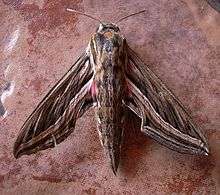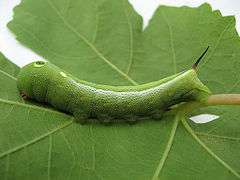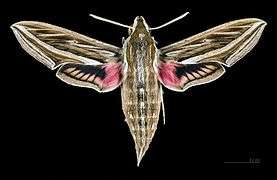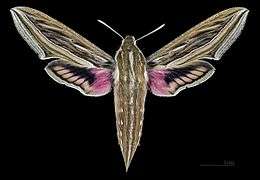Hippotion celerio
| Hippotion celerio | |
|---|---|
 | |
 | |
| Scientific classification | |
| Kingdom: | Animalia |
| Phylum: | Arthropoda |
| Class: | Insecta |
| Order: | Lepidoptera |
| Family: | Sphingidae |
| Genus: | Hippotion |
| Species: | H. celerio |
| Binomial name | |
| Hippotion celerio (Linnaeus, 1758)[1] | |
| Synonyms | |
| |
Hippotion celerio, the vine hawk-moth or silver-striped hawk-moth, is a moth of the family Sphingidae.
Distribution
It is found in Africa and central and southern Asia of India, Sri Lanka and, as a migrant in southern Europe and Australia.

Description
The forewing is typically 28–35 millimetres (1.1–1.4 in) long.

 Male
Male Male underside
Male underside Female
Female Female underside
Female underside
Colouring and marks
The body and forewing of the adult moth are green and ochre. They have silvery white dots and streaks, with a silvery band running obliquely on the forewing. The hindwing is red near its lower angle (tornus) to pinkish over other parts of the wing. It is crossed by a black bar and black veins. There is greater variation. In f. pallida Tutt the ground coloration ia a pale terracotta ground; in f. rosea Closs, the wings have a red suffusion; in f. brunnea Tutt, the suffusion is deep brown. In f. augustei Trimoul, the black markings cover the entire wings; in f. luecki Closs, all silver markings are absent and in f. sieberti Closs, the forewing oblique stripe is yellowish, not silver.
Similar species
- Hippotion osiris larger size and lacks the black venation on the hindwing.
- Hippotion aporodes may be only a very dark subspecies of celerio - in this form, the silvery streak on the forewing is not present but other markings are intensified. In addition, the hindwing is mainly brownish.
"Head and thorax as in eson; abdomen with a white spot on each segment between the dorsal white lines; a pair of silvery lateral strigae on each segment. Fore wing paler; some silvery streaks on the median nervure; the nervules beyond the cell streaked with silvery white and black; a silvery-white line from apex to near base of inner margin, followed by some ochreous and pale brown lines; a white submarginal line; the markings are thus similar to oldenlandiae, except that the lines that come out white are different. Hind wing with the base and anal angle bright pink; disk blackish; the outer area ochreous brown, with a black submarginal line and the nervules between it and the cell black. Larva brown; a series of whitish ocelli with darker centers from 4th to 10th somites; horn and underside white."
—The Fauna of British India Including Ceylon and Burma Moths Vol-1.[2]
Biology
Larva
Larvae may be green, yellowish green or even brown. They have a dark broken mid-dorsal line and a creamy dorso-lateral line from the fifth segment to the horn. The head is round, and usually a dull green colour. The larva has a horn which is usually long and straight. There is a large yellow and green eyespot on the third segment and a smaller one on the fourth segment.
Larvae typically feed on the leaves of plants such as the grape vine, Cissus, Impatiens and the Arum lily.
References
- ↑ "CATE Creating a Taxonomic eScience - Sphingidae". Cate-sphingidae.org. Retrieved 2011-10-25.
- ↑ Hampson G. F. (1892). "The Fauna of British India Including Ceylon and Burma Moths Vol-i". Digital Library of India. p. 558. Retrieved 4 July 2016.
- Pinhey, E. (1962): Hawk Moths of Central and Southern Africa. Longmans Southern Africa, Cape Town.